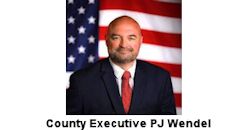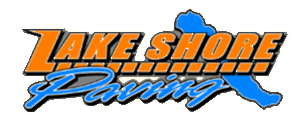The Leader (SUNY Fredonia)
by Jeff Woodard
March 27, 1995
Damore keeps calendar full as SUNYAC Commissioner
Take the weekend of Feb. 22. True, Feb. 22, 1995 fell on a Wednesday, but that’s when Damore hopped in his Grand Marquis, with the familiar “SUNYAC 1” license plate, and hit the road. He was in Fredonia, Geneseo, Cortland, Albany, and back to Fredonia, all in a matter of six days. Along the way, he handed out trophies to the best men’s and women’s basketball teams and best swimmers in the SUNYAC. In between trophy presentations, he got updates from the hockey semi-finals that were going on simultaneously in Fredonia and Plattsburgh. After that, it was on to Albany, where he met with state legislative leaders Joseph Bruno and Sheldon Silver, and sat in on a conversation with Governor Pataki.
That schedule is nothing new to Patrick R. Darmore, Ph.D, who has been a part of the State University of New York Athletic Conference for over 35 years. These days, though, he’s wearing another hat. When he’s not acting as Commissioner of SUNYAC, he’s a trustee on the Fredonia Village Board.
While politics has become Damore’s second job, athletics will always be his first love. His stately office on the third floor of Mason Hall is decorated with memorabilia dating back to the 1950s,
Darmore earned his bachelor’s degree in health and physical education from Brockport State, and followed that with a Master’s Degree in education from St. Lawrence University, and an Educational Doctorate from the University of Oklahoma. He served in the Navy from 1953-1954, before getting his first coaching job at a tiny school in the Adirondacks – Hammond Central.
“I was the only coach there,” said Darmore, who coached basketball, soccer, baseball, and track. “It was a good place to start because it covered all aspects of the job.” He coached the basketball team to the St. Lawrence Valley Championship and the section Ten, Class D title in two years. Using the credentials he accumulated there, he moved from a small high school to a small college, as he accepted a faculty/coaching position at the Fredonia State Teacher’s College in 1956. He was assigned to set up an elementary physical education program.
In 1958, Darmore played a key role in setting up Fredonia’s first fall sport, soccer. “Brockport was a national power in soccer when I was in school, so I thought we should have a fall sport here,” he said. Damore got together with his athletic director, and by 1959 the varsity soccer program was ready for its inaugural season.
“We had a great first year,” Damore said as he pulled down a picture of that first team from a top shelf. He had to blow on it to get all the dust off the glass. Darmore recalled that first season, and as he did he looked at that picture as if he was looking and reminiscing about old friends instead of a group of athletes he once coached.
The team won its first two games before dropping the final three games that first year. “We were almost investigated (after the first two games) because other schools couldn’t figure out how we were winning,” he said with a shrewd grin.
“The problem was we had a bunch of guys who had football skills, not soccer skills,” said Pete Criscione, a member of the first soccer team. “(Damore) would like to take us to Buffalo to watch soccer clubs and say, ‘Play like them,’ and it was just impossible. But he never gave up on us.”
The next year featured the biggest win ever for the fledgling soccer program. Fenn College of Cleveland (now Cleveland State) was unbeaten, untied, and to some, unstoppable. “They had a record of something like 32-0. So we scheduled them, went there, and beat them 5-2,” Darmore said. He has a souvenir from this game too – a newspaper article about the game, under glass, on a plaque.
“I bent over to tie my shoes, and it was 1-0 Fenn,” Damore recalled. “I told Pete (Cirscione) he didn’t have to score. All he had to do was stop their All-American from scoring, and he did. He shut him down.”
“They (Fenn) didn’t want to play us after a while,” Criscione said. “With our football background, we were so much more aggressive, some of their players just walked off the field and didn’t want to play.”
Soccer was just one of the sports Damore coached while he was a faculty member at Fredonia State. He also headed up the basketball and tennis teams. Coaching three sports is something that just can’t be done by one person anymore, even at the Division III level, according to Damore.
“The games have become so highly skilled, and recruiting is a big part of it,” he said. “That’s where I got caught when I used to coach soccer and basketball, and recruit for both. Somebody would come in the door and I wouldn’t know if they were there for soccer or basketball.”
Yet Damore continued his multiple coaching duties until 1968, when he was named Fredonia State’s Athletic Director. He served in that capacity for 18 years.
Meanwhile, the State University of New York Athletic Conference was founded soon after the completion of Fredonia’s first soccer season. Originally called the New York State Intercollegiate Athletic Conference in 1958, the name changed to SUNYAC in 1963.
Over the next couple of decades, athletic competition in the conference changed dramatically, according to Damore. “SUNYAC is tough,” he said. “It’s (now) one of the best Division III conferences in the country.” Damore used this year’s basketball season as an example. Of the twelve men’s teams in the conference, four went to the NCAA national tournament, and three more went to the ECAC tournament (Fredonia won the ECAC Championship). “Overall, we’ve really grown.”
From the beginning of the SUNYAC until the mid-1970s, the conference didn’t have a commissioner. Instead the executive committee and president handled the duties. Athletic Directors of the conference schools took turns as president. In 1978, a proposal was made to create the commissioner’s office. Damore, who had served as SUNYAC’s president the two previous years, took the job in a part-time capacity, keeping his A.D. position at Fredonia. His duties as SUNYAC commissioner have included coordinating schedules, tournaments, publicity for the conference, and of course, handing out trophies at championship events.
During his career, Damore has earned acclamation after acclamation. He’s been the president of the Intercollegiate Soccer Association of America, president of the Collegiate Division Commissioner’s Association, as well as SUNYAC president. His awards include the SUNYAC Distinguished Service Award, and the Naval Commendation Award. He is a member of the National Association of Collegiate Directors of Athletics Hall of Fame, and both the Fredonia and Brockport Athletic Halls of Fame.
In 1985, Damore and his first wife,Nancy, traveled to Texas. He was there to help set up a commissioner’s office in the Lonestar Conference, a small athletic conference similar to SUNYAC. Damore had planned on retiring from both the A.D. and SUNYAC positions. “We were both going to retire and move down there,” he said. “But she passed away… that changed my whole thought pattern.”
While he hadn’t started looking for a job in Texas yet, the executive board of SUNYAC didn’t want to take any chances on losing him. They offered him the commissioner’s post in a full-time capacity.
“I told them I’d stay, only if I could stay in Fredonia, because I didn’t want to move to Syracuse or someplace. They said, ‘Fine, if you want to do the driving, that’s up to you.”
The offer by SUNYAC to make Damore a full-time commissioner wasn’t the only thing that kept him here. An innocent conversation with the then-soccer coach (and current Fredonia Athletic Director) Tom Prevet was the final deciding factor.
Damore was getting ready for a trip out of town, and needed some minor work done on his car. He called the local shop where he’d always had his car repaired. “I said, ‘Mark, this is Pat. I need to get some work done,’” Damore said, “Mark said he could squeeze me in around 1 p.m. for a half-hour or so.”
“I hung up the phone and Prevet said, “See? You think if you were in Austin or Houston right now you could call someone up and say ‘This is Pat.’ You don’t have any connections out there. All your friends are here.’ So I decided to stay.”
Prevet doesn’t remember that conversation, but said he’s glad he had it. “I’d had an excellent relationship with Pat,“ Prevet said.
Prevet replaced Damore as head soccer coach when Damore became athletic director. “When you replace a soccer coach, there’s always the camaraderie. He certainly knew what difficulties I had as a coach, so we could relate really well.”
In fact, he not only relates well with coaches, but with other athletic directors as well. “I’ve known Pat for 26 years now, and he’s never changed. He’s always had the same demeanor,” said John Spring, Athletic Director at SUNY Geneseo. “We (the AD’s in SUNYAC) are like his family.” Spring was Damore’s host during the basketball and swimming championships. “We went out for a drink Wednesday night, and had lunch Thursday afternoon,” Spring said. “He loves that hectic schedule. He always seems to have things under control.”
When he’s not on the road at other SUNYAC schools, he spends much of his workday in the SUNYAC office. With the help of his secretary, Judy Leva, and SUNYAC publicist Betsy McCormack, Damore coordinates game sites, referee scheduling, and publicity.
‘He’s got a good head for the business aspect,” McCormack said. “Plus, it’s not really a typical office, it’s really casual. Sometimes (Damore) will come during the summer wearing boat shoes.”
Damore doesn’t really need to worry about the kind of shoes he wears during the summertime, or anytime for that matter. Anyone who’s anyone in the Fredonia community knows Pat Damore. “He’ll take us to lunch and he’ll stop and talk to 15 people wherever he goes,” McCormack said.
The people Damore sees everyday convinced him to enter the political ring last year. “I wanted to help a lot of these people who need help and nobody else pays attention to,” Damore said. “I like to watch out for the small person.”
Damore credits out-going Fredonia Mayor Louis Mancuso for getting him onto politics. “I knew he was an outstanding worker and a long-time resident,” Mancuso said.
The SUNYAC schedule doesn’t interfere with Damore’s duties as village trustee, according to Mancuso. “He’s able to work around it,” Mancuso said. “His (SUNY) work comes in clusters. He’s one of the hardest working guys down here.” Damore usually spends a couple of hours at the end of the working day at village hall.
The only retiring Damore does these days is to his Howard Street home at the end of his busy day with his wife Doranne, a secretary in the office of Donald A. MacPhee, president. In the summertime, when activity in the office is light, he escapes to the golf course, or to his boat on Lake Erie.
While many people sacrifice something in order to succeed, Damore said the hectic schedule hasn’t kept him from the finer things in life. “I’ve done everything I’ve wanted to do,” he said.
Damore maneuvers such a tight schedule, he’d make even the hardest working college student jealous. But how much longer will Damore, who’s been a part of athletics at Fredonia for almost four decades, continue with a schedule like this? “I’m not thinking about retirement,” Damore said. “People who retire want to travel. I get enough traveling in.”
The additional financial assistance of the community is critical to the success of the Chautauqua Sports Hall of Fame.
We gratefully acknowledge these individuals and organizations for their generous support.












